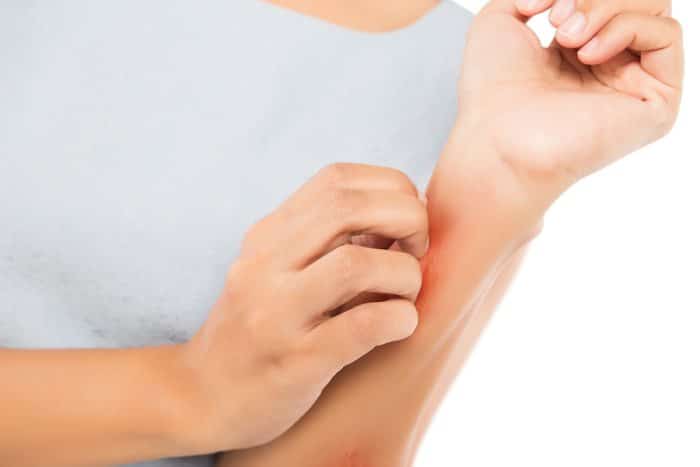Pruritus
Definition and Etiology

|
Pruritus or itch is simply defined as any unpleasant sensation of the skin that provokes the urge to scratch. It is a characteristic feature of many skin diseases and an unusual sign of some systemic diseases. |
Pruritus may be localized or generalized and can occur as an acute or chronic condition. Itching lasting more than 6 weeks is termed chronic pruritus. Itching can be intractable and incapacitating, as well as a diagnostic and therapeutic challenge.
Pathophysiology
Peripheral Mechanisms
- Physical Stimuli and Neural Pathways
Itch can be produced by mechanical (gentle touch, pressure, vibration, and wool), thermal and electrical stimuli such as transcutaneous or direct nerve stimulation.
The sensation is received by free nerve endings in the skin and transmitted via unmyelinated C fibers Opens in new window and myelinated Aδ fibers Opens in new window to the central spinothalamic tracts Opens in new window. Microneurography Opens in new window studies have demonstrated that itch and pain are transmitted by separate neural pathways.
- Chemical Mediators
Histamine Opens in new window is one of the most important mediators of itch, although other chemical substances have also been implicated. Some, such as neuropeptides Opens in new window, act by releasing histamine from mast cells, and itching caused by them responds to antihistamines.
Others act independently; therefore antihistamines are not effective in some forms of pruritus. Opioids Opens in new window have a central pruritic action and also act peripherally by augmenting histamine itch.
| Table X-1 | Select Dermatologic Disorders Associated with Chronic Pruritus | |
|---|---|
| Autoimmune Dermatitis herpetiformis Dermatomyositis Pemphigoid Sjögren’s syndrome | Genetic Darier’s disease Hailey-Hailey disease Ichthyoses Sjögren-Larsson syndrome |
| Infections and Infestations Arthropod reactions Dermatophytosis Folliculitis Impetigo and other bacterial infections Insect bites Pediculosis Scabies Viral | Inflammatory Asteatosis (dry skin), including aging and senile pruritus Atopic eczema Contact dermatitis (irritant, alleric) Drug reactons Invisible drmatoses Lichen planus Lichen simplex chronicus Mastocytosis (urticaria pigmentosa) Miliaria Scars Urticaria |
| Neoplastic Cutaneous T-cell lymphoma or mycosis fungoides (especially Sézary syndrome) Cutaneous B-cell lymphoma Leukemia cutis | Pregnancy Pemphigoid gestations Polymorphic eruption of pregnancy Prurigo gestationis |
| Adapted from Pujol RM, Gallardo F, Listosella E, et al: Invisible mycosis fungoides: A diagnostic challenge. J Am Acad Dermatol 2002; 47:S167-S171; and Stander S, Weisshaar E, Mettang T, et al: Clinical classification of itch: A position paper of the International Forum for the Study of Itch. Acta Derm Venereol 2007;87:291-294. | |
Central Mechanism
Patients with tumors and lesions of the central nervous system have been reported to have intractable pruritus. Administration of opioids in epidural anesthesia can also lead to pruritus.
Etiology
Itching is associated with dermatologic and systemic causes, and it is important to determine whether there is an associated skin eruption. A characteristic rash usually establishes the diagnosis of a primary dermatologic disorder.
Several skin diseases are associated with pruritus; some are listed in Table X-1 . Itching is an important component of some disorders (atopic eczema Opens in new window, dermatitis herpetiformis Opens in new window, lichen simplex chronicus Opens in new window, and nodular prurigo Opens in new window) and these conditions are rarely diagnosed in its absence.
In conditions such as mild urticaria or aquagenic pruritus, the levels of histamine are sufficient for a sensory but not a vascular response, and there may be no skin findings.
Bullous pemphigoid Opens in new window can manifest with a prebullous pruritic phase for several months before the characteristic blisters appear. An invisible form of mycosis fungoides Opens in new window can occur as pruritus without a rash and is diagnosed on biopsy.
| Table X-2 | Select Systemic Causes of Chronic Pruritus | |
|---|---|
| Endocrine and Metabolic Diseases Chronic renal failure Diabetes mellitus (questionable; may be localized to scalp) Hyperthyroidism Hypothyroidis Liver disease (with or without cholestasis) Malabsorption Perimenopausal pruritus | Infectious Diseases Helminthosis HIV infection Paraitosis |
| Neoplastic and hematological Hodgkin’s disease Iron deficiency Leukemia Non-Hodgkin’s lymphoma Multiple myeloma Plasmacytoma Polycythemia rubra vera | Visceral Neoplasms Carcinoid syndrome Solid tumors of the cervix, prostate, or colon |
| Pregnancy Pruritus gravidarum (with or without cholestasis) Drugs Allopurinol Amiodarone Angiotensin-converting enzyme inhibitors Estrogen Hydrochlorothiazide Hydroxyethyl cellulose Opioids Simvastatin | Other Neurologic disease - Abscess - Infarcts - Multiple sclerosis - Nostalgia paresthetica - Tumors Psychiatric disease - Anxiety disorders - Depression - Obsessive-compulsive disorder |
| Adapted from Pujol RM, Gallardo F, Listosella E, et al: Invisible mycosis fungoides: A diagnostic challenge. J Am Acad Dermatol 2002; 47:S167-S171; and Stander S, Weisshaar E, Mettang T, et al: Clinical classification of itch: A position paper of the International Forum for the Study of Itch. Acta Derm Venereol 2007;87:291-294. | |
It is important to establish if pruritus preceded the appearance of a skin eruption. Severe itching leads to scratching that causes secondary skin changes of excoriation, lichentification, dryness, eczematization, and infection.
Excessive bathing and contact allergy Opens in new window to topical therapies can lead to dermatitis. These findings should not be interpreted as the primary skin disorder.
Select systemic conditions associated with itching are listed in Table X-2 . Several are potentially serious, and it can be dangerous to label a case of generalized pruritus “nonspecific eczema” until these conditions are excluded.
Pruritus of systemic disease is usually generalized, it may be the only manifesting symptoms, and a specific rash is not present. Neurologic and psychiatric conditions associated with chronic pruritus are include in Table X-2 .
Diagnosis
A detailed history is the single most important step toward diagnosing the cause of itching. This should include information on the onset, extent (generalized vs. localized), severity, type of itch, aggravating and alleviating factors, diurnal and seasonal variations, bathing, occupation, hobbies, medication history and allergies, and past medical and surgical history.
Inquire about personal or family history of atopy (childhood eczema, allergic rhinitis, asthma), household and other contacts, pets, travel history, sexual history, and history of intravenous drug use (human immunodeficiency virus [HIV] or hepatitis C infection).
If the patient has recently undergone surgery, ask if hydroxethyl cellulose was used as a plasma expander, because this substance can be associated with intense generalized pruritus lasting for up to one year.
Therapeutics
General Concepts and Topical and Systemic Treatments
Identifying and treating the underlying cause is the most effective therapy for pruritus. Symptomatic treatment should be prescribed while the primary condition is being treated.
Cool compresses and cool baths might help relieve the itch; a cool environment in the home and workplace also helps. Cooling lotions with calamine, pramoxine, or menthol and camphor are helpful.
Pruritus due to dry skin, especially in the elderly, responds to generous amounts of emollients such as petrolatum and white paraffin, as well as correcting the temperature and humidity.
Patients should avoid frequent and hot baths and excessive use of soap, which further dries the skin. Topical corticosteroids should not be prescribed indiscriminately but should be used only if there are signs of cutaneous inflammation.
Topical tacrolimus may be prescribed for limited use in patients with atopic dermatitis. Topical capsaicin may be useful in chronic localized pruritus such as nostalgia paresthetica.
H1-receptor antihistamines are the drugs of choice for urticaria. The newer nonsedating antihistamines are less effective in atopic dermatisis; the older sedating antihistamines might work better.
Tricyclic antidepressants such as doxepin have antihistamine activity in addition to central effects and are useful in chronic, severe pruritus. Gabapentin, buspirone, and selective serotonin reuptake inhibitors (SSRIs) may be considered in select patients.
Ultraviolet (UV) B phototherapy is very effective in uremic pruritus and may be helpful in patients with prurigo nodularis, atopic dermatitis, HIV infection, and aquagenic pruritus.
Opioid-receptor antagonists, such as naloxone, have occasionally been used for intractable pruritus of renal and cholestatic diseases. Other measures that have been tried for chronic pruritus are acupuncture and transcutaneous electrical nerve stimulation (TENS).
Aggressive treatment of the eczema may be the only way to control the pruritus in patients with atopic dermatitis. Limited use of systemic corticosteroids as well as other systemic immunosupressives may be needed to treat eczema.
- Alonso-Llamazares J, Rogers RS III< Oursler JR, Calobrisi SD: Bullous pemphigoid presenting as generalized pruritus: Observation in six patients. Int J Dermatol 1998;37:507-514.
- Bernhard JD: Pruritus in skin disease. In Bernhard JD: Itch: Mechanisms and Management of Pruritus. New York, McGraw-Hill, 1994, pp 37-67.
- Greaves M: Mediators of pruritus. In Bolognia JL, Jorizzo JL, Rapini RP (eds): Dermatology. St Louis, Mosby, 2003, pp 85-94.
- Hagermark O, Wahlgren C: Treatment of itch. Semin Dermatol 1995;14:320-325.
- Kantor GR, Bernhard J: Investigation of the pruritic patient in daily practice. Semin Dermatol. 1995;14:290-296.
- Pujol RM, Gallardo F, Llistosella E, et al: Invisible mycosis fungoides: A diagnostic challenge. J Am Acad Dermatol 2002;47:S167-S171.
- Ständer S, Steinhoff M, Schmelz, M, et al: Neurophysiology of pruritus: cutaneous elicitation of itch. Arch Dermatol 2003; 139:1463-1470.
- Ständer S, Weisshaar E, Mettang T, et al: Clinical Classification of itch: A position paper of the International Forum for the Study of Itch. Acta Derm Venereol 2007:87 291-294.
- Ward JR, Bernhard JD: Pruritus. In Lebwohl M, Heymann WR, Berth-Jones J, Coulson I (eds): Treatment of Skin Disease, 2nd ed. St Louis, Mosby Elsevier, 2006, pp 533-537.
- Zirwas MJ, Seraly MP: Pruritus of unknown origin: A retrospective study. J Am Acad Dermatol 2001;45:892-896.

